动词ing做宾补-表语-定语-状语及综合练习
- 格式:docx
- 大小:23.24 KB
- 文档页数:14
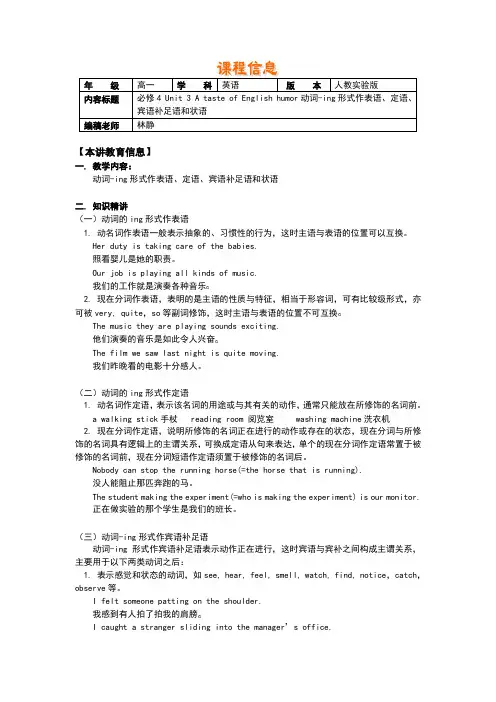
年级高一学科英语版本人教实验版内容标题必修4 Unit 3 A taste of English humor动词-ing形式作表语、定语、宾语补足语和状语编稿老师林静【本讲教育信息】一. 教学内容:动词-ing形式作表语、定语、宾语补足语和状语二. 知识精讲(一)动词的ing形式作表语1. 动名词作表语一般表示抽象的、习惯性的行为,这时主语与表语的位置可以互换。
Her duty is taking care of the babies.照看婴儿是她的职责。
Our job is playing all kinds of music.我们的工作就是演奏各种音乐2. 现在分词作表语,表明的是主语的性质与特征,相当于形容词,可有比较级形式,亦可被very, quite,so等副词修饰,这时主语与表语的位置不可互换The music they are playing sounds exciting.他们演奏的音乐是如此令人兴奋The film we saw last night is quite moving.我们昨晚看的电影十分感人。
(二)动词的ing形式作定语1. 动名词作定语,表示该名词的用途或与其有关的动作,通常只能放在所修饰的名词前。
a walking stick手杖 reading room 阅览室 washing machine洗衣机2.现在分词作定语,说明所修饰的名词正在进行的动作或存在的状态,现在分词与所修饰的名词具有逻辑上的主谓关系,可换成定语从句来表达,单个的现在分词作定语常置于被修饰的名词前,现在分词短语作定语须置于被修饰的名词后。
Nobody can stop the running horse(=the horse that is running).没人能阻止那匹奔跑的马。
The student making the experiment(=who is making the experiment) is our monitor.正在做实验的那个学生是我们的班长。

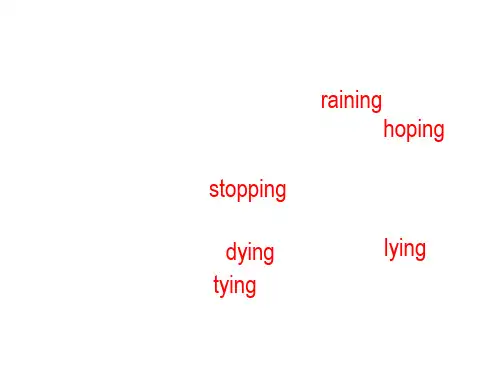

动词ing做宾补-表语-定语-状语及综合练习2高中英语语法动词ing形式做宾补表语定语状语用法详解及练习第一部分:动词的-ing形式作宾语补足语1.动词的-ing形式可以在see, hear, notice, watch, feel, smell, look at, listen to, observe, find 等表示感官和心理状态的动词后面作宾语补足语,和一个名词或代词一起构成复合宾语。
We heard the children shouting upstairs. 我们听见孩子们在楼上叫喊。
I noticed a man running out of the bank when I got off the car. 我下车的时候注意到一个男人从银行里跑出来。
I felt my heart beating violently. 我觉得我的心在猛烈地跳动。
2.动词的-ing形式和不定式作宾语补语的区别在see, hear, feel, watch, notice等感官动词后,既可用动词的-ing形式构成复合宾语,也可用不定式构成复合宾语,两者之间有一定的区别。
用动词的-ing形式时,表示动作正在进行;用不定式时,表示动作发生了,即动作的全过程结束了。
He saw a girl getting on the car. 他看见一个女孩在上汽车。
(She was getting on the car.)He saw a girl get on the car and drive off. 他看见一个女孩上车开走了。
(She got on the car and drove off.)Do you hear someone knocking at the door 你听见有人在敲门吗?(Someone is knocking at the door.)Do you hear someone knock at the door 你听见有人敲门了吗?(Someone knocked at the door just now.)提示:如果宾语补足语是一系列的动作,通常只能用不定式来表示,不用动词的-ing形式。
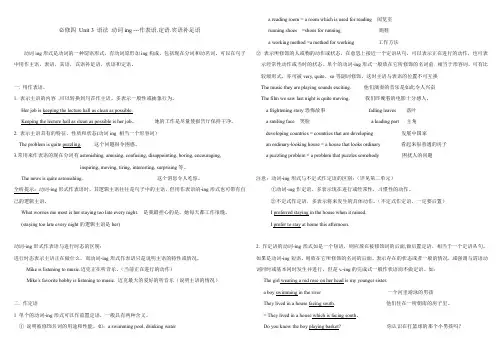
必修四Unit 3 语法动词ing ---作表语.定语.宾语补足语动词ing形式是动词的一种谓语形式,有动词原形加ing构成,包括现在分词和动名词。
可以在句子中用作主语,表语,宾语,宾语补足语,状语和定语。
一.用作表语。
1. 表示主语的内容,可以转换到句首作主语。
多表示一般性或抽象行为。
Her job is keeping the lecture hall as clean as possible.Keeping the lecture hall as clean as possible is her job。
她的工作是尽量使报告厅保持干净。
2. 表示主语具有的特征、性质和状态(动词ing 相当一个形容词)The problem is quite puzzling. 这个问题很令困惑。
3.常用来作表语的现在分词有astonishing, amusing, confusing, disappointing, boring, encouraging,inspiring, moving, tiring, interesting, surprising等。
The news is quite astonishing. 这个消息令人吃惊。
全析提示:动词-ing形式作表语时,其逻辑主语往往是句子中的主语,但用作表语的-ing形式也可带有自己的逻辑主语。
What worries me most is her staying too late every night. 是我最担心的是,她每天都工作很晚。
(staying too late every night的逻辑主语是her)动词-ing形式作表语与进行时态的区别:进行时态表示主语正在做什么,而动词-ing形式作表语只是说明主语的特性或情况。
Mike is listening to music.迈克正在听音乐。
(当前正在进行的动作)Mike’s favorite hobby is listening to music. 迈克最大的爱好的听音乐(说明主语的情况)二. 作定语1 单个的动词-ing形式可以作前置定语,一般具有两种含义。
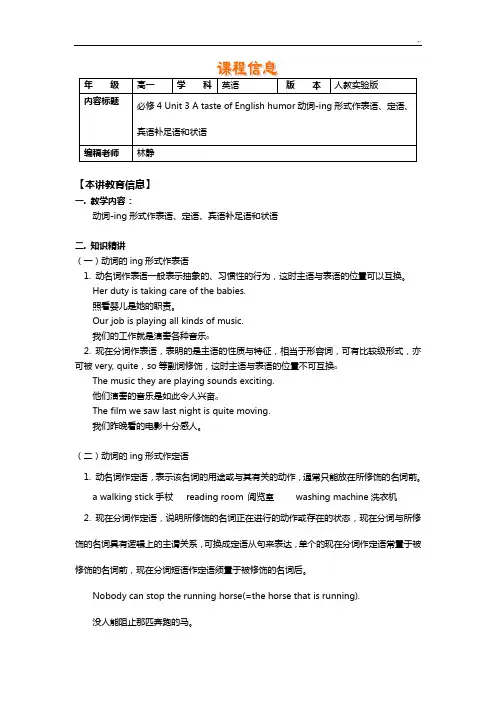
年级高一学科英语版本人教实验版内容标题必修4 Unit 3 A taste of English humor动词-ing形式作表语、定语、宾语补足语和状语编稿老师林静【本讲教育信息】一. 教学内容:动词-ing形式作表语、定语、宾语补足语和状语二. 知识精讲(一)动词的ing形式作表语1. 动名词作表语一般表示抽象的、习惯性的行为,这时主语与表语的位置可以互换。
Her duty is taking care of the babies.照看婴儿是她的职责。
Our job is playing all kinds of music.我们的工作就是演奏各种音乐2. 现在分词作表语,表明的是主语的性质与特征,相当于形容词,可有比较级形式,亦可被very, quite,so等副词修饰,这时主语与表语的位置不可互换The music they are playing sounds exciting.他们演奏的音乐是如此令人兴奋The film we saw last night is quite moving.我们昨晚看的电影十分感人。
(二)动词的ing形式作定语1. 动名词作定语,表示该名词的用途或与其有关的动作,通常只能放在所修饰的名词前。
a walking stick手杖reading room 阅览室washing machine洗衣机2.现在分词作定语,说明所修饰的名词正在进行的动作或存在的状态,现在分词与所修饰的名词具有逻辑上的主谓关系,可换成定语从句来表达,单个的现在分词作定语常置于被修饰的名词前,现在分词短语作定语须置于被修饰的名词后。
Nobody can stop the running horse(=the horse that is running).没人能阻止那匹奔跑的马。
The student making the experiment(=who is making the experiment) is our monitor.正在做实验的那个学生是我们的班长。
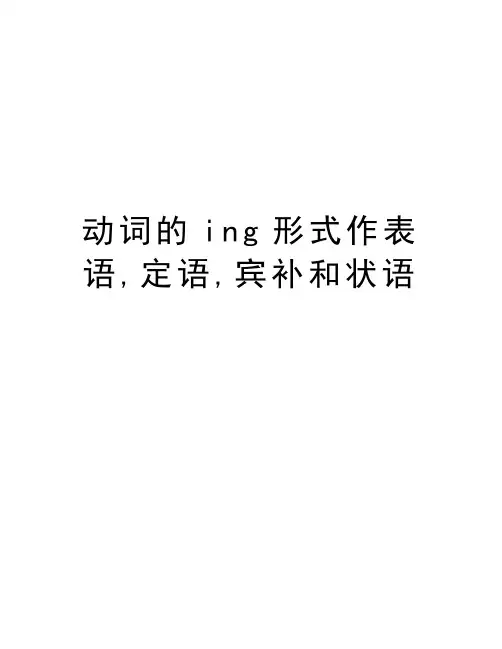
动词的i n g形式作表语,定语,宾补和状语动词的ing形式作表语,定语,宾补和状语一、动词-ing形式作表语1. 表示主语的内容 ,可以转换到句首作主语Her job is keeping the lecture hall as clean as possible. (= keeping the lecture hall as clean as possible is her job)她的工作是尽量使报告厅保持干净。
2. 表示主语具有的特征、性质和状态(动词ing 相当一个形容词)The problem is quite puzzling.这个问题很令困惑。
3.常用来作表语的现在分词有astonishing, amusing, confusing, disappointing, boring, encouraging, inspiring, moving, tiring, interesting, surprising等。
全析提示:动词-ing形式作表语时,其逻辑主语往往是句子中的主语,但用作表语的-ing形式也可带有自己的逻辑主语。
What worries me most is her staying too late every night. (staying too late every night的逻辑主语是her)二、动词-ing形式作定语1 单个的动词-ing形式可以作前置定语,一般具有两种含义。
①说明被修饰名词的用途和性能。
a reading room = a room which is used for reading 阅览室running shoes =shoes for running 跑鞋a working method =a method for working 工作方法②表示所修饰的人或物的动作或状态,在意思上接近一个定语从句,可以表示正在进行的动作,也可表示经常性动作或当时的状态。
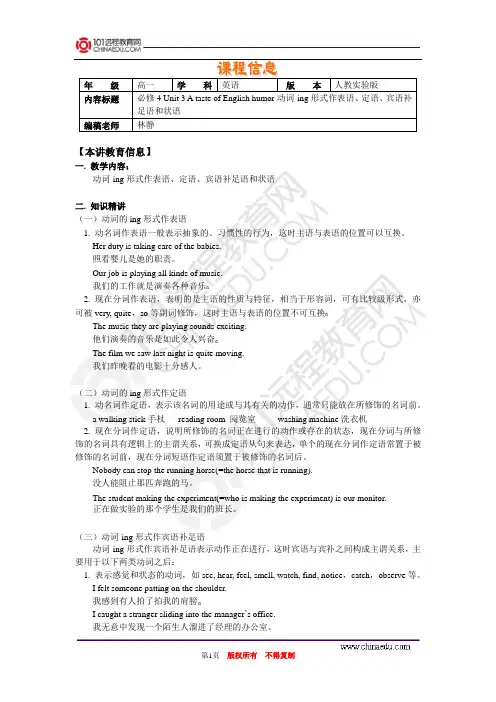
年级高一学科英语版本人教实验版内容标题必修4 Unit 3 A taste of English humor动词-ing形式作表语、定语、宾语补足语和状语编稿老师林静【本讲教育信息】一. 教学内容:动词-ing形式作表语、定语、宾语补足语和状语二. 知识精讲(一)动词的ing形式作表语1. 动名词作表语一般表示抽象的、习惯性的行为,这时主语与表语的位置可以互换。
Her duty is taking care of the babies.照看婴儿是她的职责。
Our job is playing all kinds of music.我们的工作就是演奏各种音乐2. 现在分词作表语,表明的是主语的性质与特征,相当于形容词,可有比较级形式,亦可被very, quite,so等副词修饰,这时主语与表语的位置不可互换The music they are playing sounds exciting.他们演奏的音乐是如此令人兴奋The film we saw last night is quite moving.我们昨晚看的电影十分感人。
(二)动词的ing形式作定语1. 动名词作定语,表示该名词的用途或与其有关的动作,通常只能放在所修饰的名词前。
a walking stick手杖reading room 阅览室washing machine洗衣机2.现在分词作定语,说明所修饰的名词正在进行的动作或存在的状态,现在分词与所修饰的名词具有逻辑上的主谓关系,可换成定语从句来表达,单个的现在分词作定语常置于被修饰的名词前,现在分词短语作定语须置于被修饰的名词后。
Nobody can stop the running horse(=the horse that is running).没人能阻止那匹奔跑的马。
The student making the experiment(=who is making the experiment) is our monitor.正在做实验的那个学生是我们的班长。
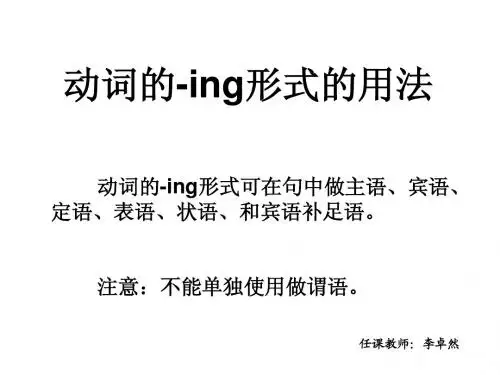
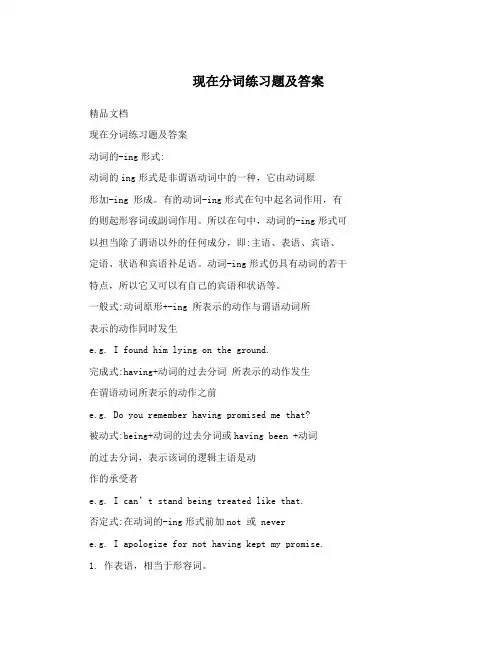
现在分词练习题及答案精品文档现在分词练习题及答案动词的-ing形式:动词的ing形式是非谓语动词中的一种,它由动词原形加-ing 形成。
有的动词-ing形式在句中起名词作用,有的则起形容词或副词作用。
所以在句中,动词的-ing形式可以担当除了谓语以外的任何成分,即:主语、表语、宾语、定语、状语和宾语补足语。
动词-ing形式仍具有动词的若干特点,所以它又可以有自己的宾语和状语等。
一般式:动词原形+-ing 所表示的动作与谓语动词所表示的动作同时发生e.g. I found him lying on the ground.完成式:having+动词的过去分词所表示的动作发生在谓语动词所表示的动作之前e.g. Do you remember having promised me that?被动式:being+动词的过去分词或having been +动词的过去分词,表示该词的逻辑主语是动作的承受者e.g. I can’t stand being treated like that.否定式:在动词的-ing形式前加not 或 nevere.g. I apologize for not having kept my promise.1. 作表语,相当于形容词。
1) The film is moving and interesting.1 / 24精品文档这部电影感人又有趣。
2) The news sounds encouraging.这个消息听起来激动人心。
pleasing, etc.)2. 作定语exciting news激动人心的消息a tiring day 累人的一天1) The man running over there is our chairman.=The man who is running over there is our chairman.这个跑过来的人是我们的主席。
2) The road joining the two villages is very wide.=The road that joins the two villages is very wide.连接两个村子的路非常的宽。

译林版必修第三册unit3单元语法练习--动词ing形式作定语,状语和宾补语法感知感知以下句子,完成方框下的小题。
以上句子中加黑部分在句中分别作以下成分:1.方式状语、2.定语、3.定语、4.宾语补足语、5.时间状语。
语法精析一、动词ing形式作定语动词ing形式作定语,有以下几种情况:1.动词ing形式作定语的位置(1)单个动词ing形式作定语,常置于被修饰的名词之前。
有些ing形式已转化为形容词,表示“令人……”。
He brought us surprising news.他给我们带来了惊人的消息。
She had to accept the disappointing fact that her son didn’t work hard.她只好接受这个令人失望的事实:她的儿子学习不努力。
(2)动词ing形式短语作定语,常置于被修饰的名词之后。
The students running along the street are from No.3 Middle School.沿着街跑步的学生来自第三中学。
Tell the boys playing over there not to make any noise.告诉那些在那儿玩的男孩别制造噪声。
2.动词ing形式作定语的用法动名词和现在分词都可以作定语,但有所区别。
(1)动名词作定语表示被修饰词的某种性能或用途,相当于for引导的介词短语。
No one is allowed to speak aloud in the reading room.阅览室里不准大声说话。
(2)现在分词作定语时,它和被修饰词之间有逻辑上的主动关系,表示所修饰词进行的动作,相当于一个定语从句。
The boy playing football on the playground is my younger brother.=The boy that/who is playing football on the playground is my younger brother.在操场上踢足球的那个男孩是我的弟弟。
动作之前。
(2)作原因状语。
E.g. Lacking enough money, they had to give up the plan.由于缺乏足够的资金,他们只好放弃了这项计划。
(3)作条件状语。
E.g. Getting the chance to study abroad, he will try his best to improve himself.如果得到到国外学习的机会,他将尽力提升自己。
(4)作结果状语。
E.g. He failed to work out the last question in the math paper, making him lose the chance to enter his ideal university.他没有能够做出数学试卷上的最后一道题,致使他失去了上理想大学的机会。
(5)作让步状语。
E.g. Working hard all the day, he still felt energetic.尽管努力工作了一整天,他仍然感到精力充沛。
(6)作伴随状语。
E.g. The girls sat together in front of the house, talking and laughing.女孩们一起坐在屋前,又说又笑。
(7)作方式状语。
E.g. They greeted each other bowing to each other.他们鞠躬彼此打招呼。
名师点拨(1)动词-ing形式作状语时相当于与之对应的状语从句,并且可互相转换。
(2)动词-ing形式作伴随状语时,则可转化成并列谓语。
E.g. Knowing what to do next, he set out to do it at once.=When he knew what to do next, he set out to do it at once.当明白下一步要做什么时,他立刻开始着手做起来。
动词+ing形式的用法动词的 -ing形式是动词的一种非谓语形式,由动词原形加 -ing构成,可以在句子中用作主语、宾语、表语、宾语补语、状语和定语。
一、动词-ing形式作主语动词-ing形式作主语常用来表示经常性或习惯性的动作。
如:Coming to Hangzhou by train takes about 16 hours.Swimming is the best sport in summer.Seeing is believing.注:有时,为了使句子保持平衡,可以用it作形式主语。
如:It’s nice talking with you.It’s a waste of time arguing with such a woman.二、动词-ing形式作宾语动词-ing形式既可作动词、短语动词的宾语,又可作介词的宾语。
1. 以下动词或短语需接动词-ing形式作宾语:admit, avoid, appreciate, consider, enjoy, finish, keep, mind, suggest等动词;dream of, feel like, give up, keep on, prefer… to, succeed in, think of等短语。
2. 在下列短语中,to是介词,后面应该用动词-ing形式作宾语:be / get used to, look forward to, devote … to, pay attention to等。
3. 有些动词既可能带-ing分词作宾语,也可以带to不定式作宾语,但在语义上却有很大的差别。
forget doing 忘记做过某事;forget to do 忘记要做某事remember doing 记得做过某事;remember to do 记住要做某事stop to do 停下来去做某事;stop doing 停止做某事mean doing 意味着做;mean to do 打算做try to do 努力做某事;try doing 试一试做某事regret doing 后悔做了某事;regret to do 遗憾要做某事can’t help doing 禁不住做;can’t help (to) do不能帮忙做chance to do 碰巧去做某事;chance doing 冒险试一试做某事go on to do 接着又做另一件事;go on doing 继续做同一件事4. 在allow, advise, permit等动词后直接跟动词-ing形式作宾语,如果这些词后面有名词或代词作宾语,其后要用动词不定式作宾语补足语。
高中英语语法动词ing形式做宾补表语定语状语用法详解及练习第一部分:动词的-ing形式作宾语补足语1.动词的-ing形式可以在see, hear, notice, watch, feel, smell, look at, listen to, observe, find等表示感官和心理状态的动词后面作宾语补足语,和一个名词或代词一起构成复合宾语。
We heard the children shouting upstairs. 我们听见孩子们在楼上叫喊。
I noticed a man running out of the bank when I got off the car. 我下车的时候注意到一个男人从银行里跑出来。
I felt my heart beating violently. 我觉得我的心在猛烈地跳动。
2.动词的-ing形式和不定式作宾语补语的区别在see, hear, feel, watch, notice等感官动词后,既可用动词的-ing形式构成复合宾语,也可用不定式构成复合宾语,两者之间有一定的区别。
用动词的-ing形式时,表示动作正在进行;用不定式时,表示动作发生了,即动作的全过程结束了。
He saw a girl getting on the car. 他看见一个女孩在上汽车。
)(She was getting on the car.)He saw a girl get on the car and drive off. 他看见一个女孩上车开走了。
(She got on the car and drove off.)Do you hear someone knocking at the door 你听见有人在敲门吗(Someone is knocking at the door.)Do you hear someone knock at the door 你听见有人敲门了吗(Someone knocked at the door just now.)提示:如果宾语补足语是一系列的动作,通常只能用不定式来表示,不用动词的-ing形式。
I saw him enter the room, sit down and light a cigarette. 我看见他走进房间,坐了下来,点燃了一根香烟。
【3.动词的-ing形式也可用在have, get, leave, keep, set, catch等表示“致使”的动词后作宾语补足语。
They should not leave us wondering what they will do next. 他们不应该不让我们知道他们下一步要做什么。
I won't have you running about in the room. 我不允许你在房间里跑来跑去。
We kept the fire burning all night long. 我们使火整夜燃烧着。
第二部分.动词的-ing形式作定语1.单个的动词的-ing形式可以作前置定语,一般有两种含义。
①说明被修饰名词的用途和性能。
a reading room= a room which is used for reading阅览室running shoes= shoes for running跑鞋(a working method = a method of working工作方法a sewing machine 缝纫机a swimming pool 游泳池a drawing board 画板a dining car 餐车a driving permit 驾驶许可证a walking stick 手杖a singing competition 歌咏比赛a waiting room 候车室②表示所修饰的人或物的动作或状态,在意思上接近一个定语从句,可以表示正在进行的动作,也可表示经常性动作或当时的状态。
developing countries = countries that are developing发展中国家·an ordinary-looking house = a house that looks ordinary看起来很普通的房子a puzzling problem = a problem that puzzles somebody困扰人的问题a disappointing play令人失望的戏剧an astonishing adventure 惊人的冒险boiling water 正在沸腾的水a sleeping baby 熟睡的婴儿a barking dog 狂吠的狗2.作定语的-ing形式如是一个短语,则应放在被修饰词的后面。
The bottle containing vinegar should be sent to the laboratory. 装着醋的那个瓶子应送到实验室去。
They lived in a house facing south. 他们住在一所朝南的房子里。
The book being discussed a lot will be published next month. 人们谈论很多的那本书下一个月将出版。
¥第三部分:.动词的-ing形式作状语动词的-ing形式可以作状语,修饰动词,在句中表示时间、原因、结果、条件、让步、行为方式或伴随情况等。
-ing形式作时间、原因、条件、让步状语时多位于句首;作结果、伴随情况状语时常位于句末。
1.表示时间,相当于一个时间状语从句。
Seeing those pictures, she remembered her childhood. 看到那些画,她想起了自己的童年。
(= When she saw those pictures...)Having made full preparations, we are ready for the examination. 我们已经作好了充分准备,现在可以应考了。
(= After we have made full preparation...)2.表示原因,相当于一个原因状语从句。
Not knowing his address, I can't send this book to him. 因为不知道他的地址,我不能把这本书送给他。
(= As I don't know his address...)Being ill, he didn't go to school yesterday. 由于生病,他昨天没有上学。
(= Since he was ill...)"3.表示结果,相当于一个并列谓语。
His father died, leaving him a lot of money. 他父亲死了,留给他许多钱。
(= ... and left him a lot of money)She was so angry that she threw the toy on the ground, breaking it into pieces. 她非常生气,把玩具扔在地上,摔成了碎片。
(= ... and broke it into pieces...)4.表示条件,相当于一个条件状语从句。
Going straight down the road, you will find the department store. 顺着这条路一直走,你就会发现那家百货商店。
(= If you go straight down the road...)Working hard at your lessons, you will succeed. 如果你努力学习,就一定能成功。
(= If you work hard at your lessons...)5.表示让步,相当于一个让步状语从句。
Knowing all this, they made me pay for the damage. 尽管知道了一切情况,他们还是要我赔偿损失。
(= Although they knew all this...)Working hard as he did, he was still unable to earn enough money to buy a car. 他虽然努力地干,但仍然挣不够买车的钱。
(= Though he worked hard as he did...)6.表示行为方式、伴随情况或补充说明,相当于一个并列结构。
He lay on the grass, staring at the sky for a long time. 他躺在草地上,长时间地望着天空。
(= ...and stared at the sky for a long time)?She came into the house, carrying a lot of books. 她捧着许多书走进了房间。
(= ...and carried a lot of books)高中现在分词用法综合练习题V-ing作主语和宾语练习题一、用所给动词的适当形式填空the task was difficult,they managed (finish) it on time.(travel) around the world and (taste) all the delicious foods in different counties.suggest (invite) him to speak on education.promised (attend) our meeting, but he didn’t turn up.practice (play) the piano in my spare time.the boys are looking forward to (feed) the animals.;always prefer (start) early rather than (leave) everything to the last minute.8. (walk) is a good form of exercise for both men and women.shopping w omen sometimes can’t help (persuade) into buying more clothes than necessary.you think it of any use (argue) with him any moreWe are wasting our time (try) to persuade hom to give up the idea.11. (make) friends is an necessary part in our life.’s no use (argue) with a person like him.are considering (go) to Hainan for the summer holiday.regret (say) that I regret (do) such a silly thing.thief ran away quickly to avoid (catch).you mind (turn) down your radio a little,pleaseis no use (keep) silent about such a matter.!(be) late made our boss very angry.teacher told the students to stop and (write,listen) to him.succeeded in (persuade) her to do the job.二、完成句子(记住开车时要多加小心)next time.(记得被邀请)to their party, but left the invitation in theoffice.I came in, he (停止读书)and looked up at me.I saw Tom, I .(停下来和他打招呼)but the ignored me.(试图完成)the work with the least cost and fewest people.decided that they would (尝试住在美国)for several years.(继续做相同的练习)。